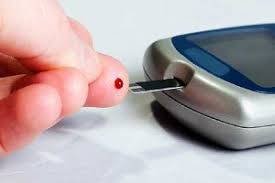- Home
- Editorial
- News
- Practice Guidelines
- Anesthesiology Guidelines
- Cancer Guidelines
- Cardiac Sciences Guidelines
- Critical Care Guidelines
- Dentistry Guidelines
- Dermatology Guidelines
- Diabetes and Endo Guidelines
- Diagnostics Guidelines
- ENT Guidelines
- Featured Practice Guidelines
- Gastroenterology Guidelines
- Geriatrics Guidelines
- Medicine Guidelines
- Nephrology Guidelines
- Neurosciences Guidelines
- Obs and Gynae Guidelines
- Ophthalmology Guidelines
- Orthopaedics Guidelines
- Paediatrics Guidelines
- Psychiatry Guidelines
- Pulmonology Guidelines
- Radiology Guidelines
- Surgery Guidelines
- Urology Guidelines
Biosensor that monitors glucose levels in tears and sweat

Constantly tracking a person's glucose levels through their tears or sweat could be one step closer to providing people with diabetes an improved monitoring tool. Researchers report in the journal ACS Nano the development of an ultra-thin, flexible sensor that could be incorporated into contact lenses or on the backs of watches for real-time glucose tracking.
Wearable sensors are part of an increasingly digitized world. But those that are commercially available typically monitor physical activities by measuring steps taken, for example, or heart rate. Creating ways to measure health markers on a molecular level has been far more challenging, but the benefits could be life-changing for some. Diagnosing and tracking conditions are often done by analyzing a sample of someone's blood. The pain of pricking fingers or drawing blood, however, can deter people from vigilantly monitoring conditions such as diabetes that require regular checks. To take the sting out of the process, wearable glucose sensors are in development but have been hampered by several factors. Some devices can't detect the low levels of glucose that are in sweat and tears, or they stop working when they're bent. Moh Amer, Chongwu Zhou and colleagues wanted to tackle these issues.
The researchers created a biosensor using nanoribbons of indium oxide, an enzyme glucose oxidase, a natural chitosan film and single-walled carbon nanotubes. When glucose is present in a test sample, it interacts with the enzyme, setting off a short chain of reactions and ultimately creating an electrical signal. Testing showed that the device could detect a range of glucose concentrations from 10 nanomolar to 1 millimolar, which is sensitive enough to cover typical glucose levels in sweat, saliva and tears in people with and without diabetes. Bending the film 100 times didn't noticeably affect its performance. In addition to glucose tracking, the researchers suggest that the sensor could also be used for monitoring in the food and environmental sectors.
Wearable sensors are part of an increasingly digitized world. But those that are commercially available typically monitor physical activities by measuring steps taken, for example, or heart rate. Creating ways to measure health markers on a molecular level has been far more challenging, but the benefits could be life-changing for some. Diagnosing and tracking conditions are often done by analyzing a sample of someone's blood. The pain of pricking fingers or drawing blood, however, can deter people from vigilantly monitoring conditions such as diabetes that require regular checks. To take the sting out of the process, wearable glucose sensors are in development but have been hampered by several factors. Some devices can't detect the low levels of glucose that are in sweat and tears, or they stop working when they're bent. Moh Amer, Chongwu Zhou and colleagues wanted to tackle these issues.
The researchers created a biosensor using nanoribbons of indium oxide, an enzyme glucose oxidase, a natural chitosan film and single-walled carbon nanotubes. When glucose is present in a test sample, it interacts with the enzyme, setting off a short chain of reactions and ultimately creating an electrical signal. Testing showed that the device could detect a range of glucose concentrations from 10 nanomolar to 1 millimolar, which is sensitive enough to cover typical glucose levels in sweat, saliva and tears in people with and without diabetes. Bending the film 100 times didn't noticeably affect its performance. In addition to glucose tracking, the researchers suggest that the sensor could also be used for monitoring in the food and environmental sectors.
Next Story
NO DATA FOUND

Disclaimer: This site is primarily intended for healthcare professionals. Any content/information on this website does not replace the advice of medical and/or health professionals and should not be construed as medical/diagnostic advice/endorsement or prescription. Use of this site is subject to our terms of use, privacy policy, advertisement policy. © 2020 Minerva Medical Treatment Pvt Ltd